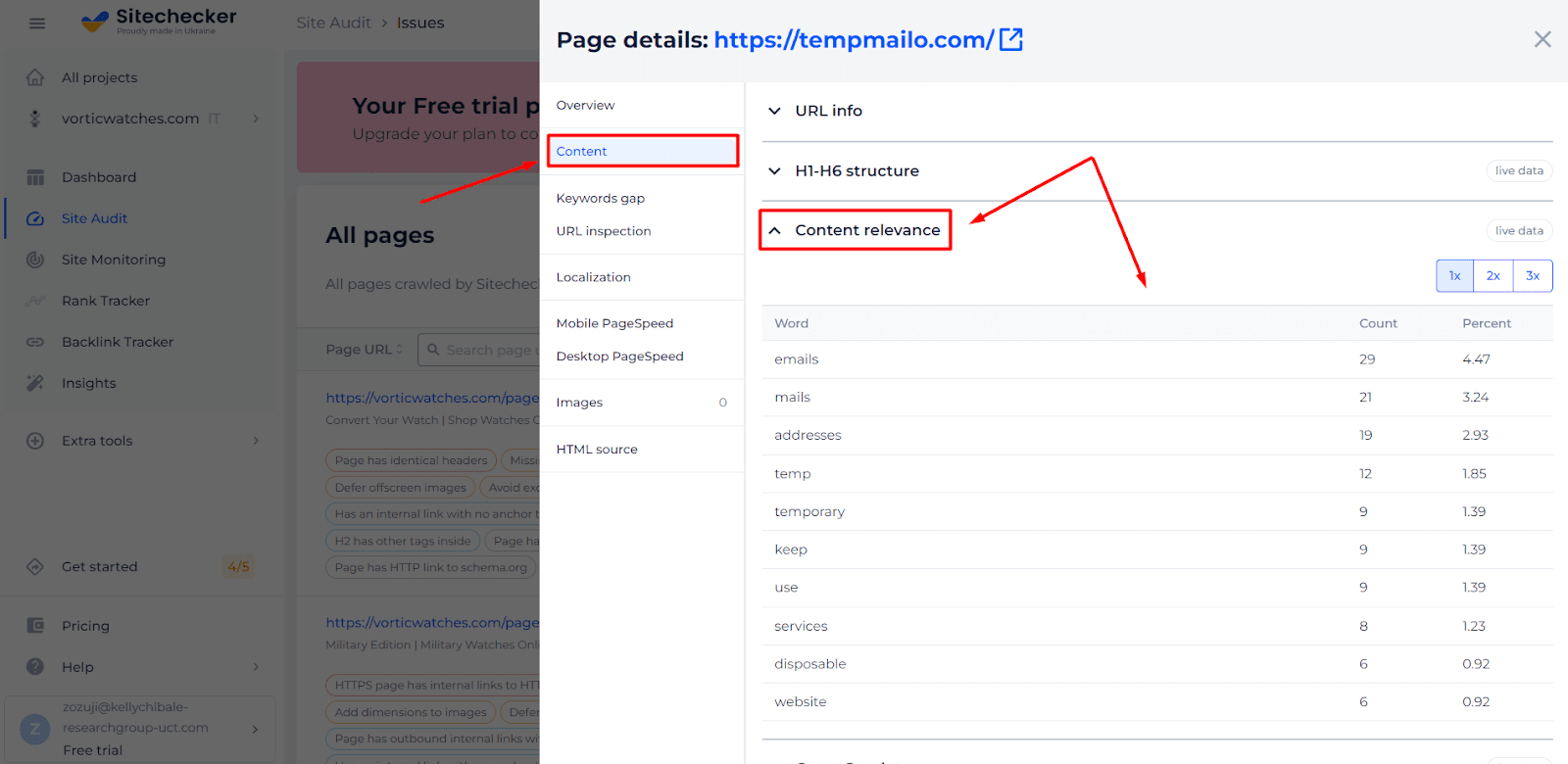What is Keyword Density?
Keyword density is one of the foundational concepts in the world of search engine optimization (SEO). It represents the frequency with which a specific term or phrase appears in search results within a piece of content, relative to the total number of words in that content.
Definition: At its core, keyword density is a percentage. It’s calculated by taking the number of times a specific phrase or keyword appears, dividing it by the total number of words in the content, and then multiplying the result by 100. The resulting figure is the keyword density percentage.
For example: If you have a 500-word article and you’ve used a specific term 10 times, the keyword density for that term would be: (10/500) * 100 = 2%
The Importance in SEO: Keyword density is significant because search engines, like Google, use it to determine the topic of a piece of content. If a term appears frequently within an article, the search engine assumes the content is more likely to be relevant to users searching for that keyword.
However, it’s crucial to strike a balance. Too high a keyword density can be seen as “keyword stuffing” and can potentially harm a page’s SEO. Conversely, too low a keyword density might make it challenging for search engines to ascertain the topic of the content.
A Changing Landscape: In the early days of SEO, keyword density was a primary factor in ranking web pages. Websites often targeted a specific “ideal” density to improve their chances of ranking well. However, as search engine algorithms have evolved, they’ve become more sophisticated. While keyword density remains a factor, it’s now one of many that search engines consider, and its importance has been somewhat diminished.
In modern SEO, the context in which a term is used, the overall quality of the content, and the user experience are increasingly vital. Keyword density is still a tool in the SEO toolkit, but it should be used judiciously and in conjunction with other strategies.
The Science Behind Keyword Density
In the realm of SEO, understanding the mechanics and nuances of keyword density is essential. This concept is more than just counting words; it’s about understanding the intricate balance between content relevance and user experience. Delving deeper, we’ll explore how keyword density is determined and what makes for an optimal keyword density.
How Keyword Density is Calculated
Keyword density might seem straightforward, but calculating it requires a meticulous approach. It’s about gauging the frequency of a phrase within a content piece relative to other words on the page or total word count.
Formula:

For instance, if an article of 1000 words features a keyword 20 times, the keyword density would be:

It’s worth noting that variations of the keyword (e.g., plurals or different tenses) are typically treated as separate keywords unless you’re using advanced tools that recognize and group such variations.
The Ideal Keyword Density
The pursuit of the “perfect” keyword density has been the subject of much debate among SEO professionals. In the earlier days of the internet, there was a belief in a magic number—a specific density that would guarantee top search rankings. However, search engines have evolved, and so has the understanding of keyword density.
No One-Size-Fits-All: There isn’t a universally accepted “perfect” keyword density percentage. What works for one piece of content or one website might not necessarily work for another. Factors such as content quality, topic relevance, and the overall user experience play significant roles in search rankings.
Guidelines Over Rules: Most SEO experts suggest a keyword density of 1-3%. This range ensures that a keyword is present enough times to signal its relevance but not so often that it appears as “stuffing.”
Context and Semantics Matter: Modern search engines use semantic search principles. They understand the context in which words are used. Therefore, it’s not just about repeating a keyword, but also about ensuring it fits naturally within the page title content and provides value to the reader.
The User Experience: Lastly, and perhaps most importantly, the user experience should never be sacrificed for the sake of keyword density. Overstuffing keywords can make content unreadable and decrease its value to users, which search engines will recognize and potentially penalize.
The Pitfalls: What is Keyword Stuffing?
In the quest to optimize content for search engines, some webmasters and content creators fall into the trap of over-optimizing, leading to a practice known as “keyword stuffing.” This tactic, while once popular, is now frowned upon and can have significant repercussions.
Definition: Keyword stuffing refers to the overuse or excessive repetition of keywords within a web page or piece of content. It often results in content that feels forced, unnatural, and provides a poor user experience.
Examples: Here are some manifestations of keyword stuffing:
- Repeating the same term in nearly every sentence, even when it doesn’t add value.
- Listing out multiple variations of a phrase with little to no context.
- Using blocks of keywords in hidden text or meta tags that are not visible to users but can be crawled by search engines.
Why it was Used: In the early days of search engines, algorithms were more rudimentary. Keyword stuffing could trick these algorithms into thinking a page was highly relevant to a specific search term, often leading to higher rankings.
Consequences: Modern search engines, like Google, have advanced algorithms that can easily detect and penalize keyword stuffing. Consequences can range from lower rankings to removal from the search index altogether. Additionally, keyword-stuffed content often provides a poor user experience, leading to higher bounce rates and decreased trust from visitors.
A Better Approach: Instead of resorting to keyword stuffing, it’s more effective and beneficial to focus on creating high-quality, user-centric content. This ensures that the content remains relevant to the keyword topic and provides genuine value to readers. Using keywords naturally and in context is key.
Best Practices for Achieving Optimal Keyword Density
Achieving the right keyword density is a delicate balance between SEO optimization and maintaining high-quality, user-friendly content. It’s not just about hitting a specific percentage; it’s about ensuring that keywords are used effectively and naturally. Here are some best practices to guide you.
1. Write for Your Audience First
Before considering search engines, your primary audience should always be your readers.
- Value Over Volume: Ensure that the content provides genuine value to readers, answering their questions and addressing their pain points.
- Natural Flow: Keywords should fit seamlessly into sentences. If it feels forced, reconsider its placement or phrasing.
- Engagement Matters: Engaging, well-written content is more likely to be shared, linked to, and recognized by search engines as valuable.
2. Strategically Place Your Keywords
While it’s important not to overdo it, strategic placement can amplify the impact of your keywords.
- Title and Headers: These are prime locations. Including keywords here can signal to both readers and search engines the primary topic of your content.
- First 100 Words: Introduce your main keyword early, ideally within the first few sentences or paragraphs.
- Meta Descriptions: Although not a direct ranking factor, including keywords in meta descriptions can increase click-through rates from search engine results.
3. Utilize Variations of Your Main Keyword
Using different forms and synonyms of your keyword can enhance content richness and avoid repetition.
- Latent Semantic Indexing (LSI): These are keywords semantically related to your main term. For instance, for the keyword “baking,” LSI keywords might include “recipes,” “oven,” or “flour.”
- Natural Language: Consider how people speak and search. They might use various terms or phrases to refer to the same concept.
4. Regularly Test and Adjust Your Keyword Density
SEO is not a one-time task; it requires continuous monitoring and adjustment.
- Analytics: Use tools to monitor how your content is performing. If certain pages with specific keyword densities are doing better, take note.
- Feedback: User feedback, comments, or surveys can provide insights into whether your content feels natural or over-optimized.
- Stay Updated: Search engine algorithms change. What works today might not work tomorrow. Regularly review and adjust your content strategy accordingly.
SEO Keyword Density Checker to Analyze Keyword Frequency on a Particular Page
The SEO Keyword Density Checker from SiteChecker is an essential tool for digital marketers and content creators who want to optimize their content for better search engine ranking. This tool provides an in-depth analysis of keyword usage on a page, identifying whether the keywords are potentially underutilized or overused — an important factor in search engine algorithms. It’s an easy-to-use solution that delivers insights into how to strategically improve content for search relevance and performance.

Beyond basic density calculation, this tool offers a breakdown of keyword usage across various HTML tags, including titles, descriptions, and headers, providing a holistic view of keyword optimization on the page. It also alerts users to any over-optimization that could be detrimental to SEO, making it a comprehensive guide for creating content that is both search engine friendly and engaging for readers. This dual functionality makes the SEO Keyword Density Checker a potent ally in the quest for organic search visibility.
Check Your Density Now!
Use our SEO Keyword Density Checker to fine-tune your SEO.
Conclusion
Navigating the intricacies of keyword density is essential for anyone invested in the digital content landscape. While it’s a pivotal aspect of SEO, the emphasis should always lean towards producing content that resonates with and provides value to the audience. Remember, search engines aim to deliver the best content to their users, and by focusing on genuine, high-quality writing, you align with this goal. As the digital realm continues to evolve, it’s crucial to adapt and refine strategies, but the constant should be the commitment to authenticity and value. In the balance between optimization and genuine content, always let the latter lead the way.









